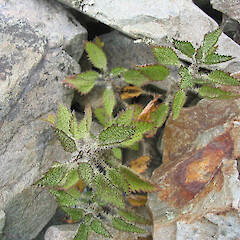Urtica aspera
Synonyms
None
Family
Urticaceae
Flora category
Vascular – Native
Endemic taxon
Yes
Endemic genus
No
Endemic family
No
Structural class
Herbs - Dicotyledons other than Composites
NVS code
The National Vegetation Survey (NVS) Databank is a physical archive and electronic databank containing records of over 94,000 vegetation survey plots - including data from over 19,000 permanent plots. NVS maintains a standard set of species code abbreviations that correspond to standard scientific plant names from the Ngä Tipu o Aotearoa - New Zealand Plants database.
URTASP
Chromosome number
2n = 24
Current conservation status
The conservation status of all known New Zealand vascular plant taxa at the rank of species and below were reassessed in 2017 using the New Zealand Threat Classification System (NZTCS) – more information about this can be found on the NZTCS website. This report includes a statistical summary and brief notes on changes since 2012 and replaces all previous NZTCS lists for vascular plants.
Please note, threat classifications are often suggested by authors when publications fall between NZTCS assessment periods – an interim threat classification status has not been assessed by the NZTCS panel.
- Conservation status of New Zealand indigenous vascular plants, 2017 . 2018. Peter J. de Lange, Jeremy R. Rolfe, John W. Barkla, Shannel P. Courtney, Paul D. Champion, Leon R. Perrie, Sarah M. Beadel, Kerry A. Ford, Ilse Breitwieser, Ines Schönberger, Rowan Hindmarsh-Walls, Peter B. Heenan and Kate Ladley. Department of Conservation. Source: NZTCS and licensed by DOC for reuse under the Creative Commons Attribution 4.0 International licence.
2017 | At Risk – Naturally Uncommon | Qualifiers: Sp
Previous conservation statuses
2012 | At Risk – Naturally Uncommon | Qualifiers: Sp
2009 | At Risk – Naturally Uncommon | Qualifiers: DP
2004 | Sparse
Distribution
Endemic. South Island, eastern from Marlborough (upper Awatere and Clarence) south to Central Otago.
Habitat
Usually montane to subalpine (>300 m a.s.l.) in short tussock grassland, grey scrub, often in and around boulders, rock tors, at the base of cliffs, on rock ledges or at the back of shallow rock overhangs. Sometimes at low elevations in pasture or along river flats. This species seems to prefer dry sites to wet ones though it is very shade tolerant.
Detailed description
Stout, erect, suberect to trailing, tufted, some shaggy-looking, grey-green, pale green to yellow-green, dioecious herb up to 400 x 600 mm, woody at base, rhizomatous, widely spreading, often forming discrete clonal patches. All parts usually densely clad in shortly stalked, fine, stinging hairs (such that plants often appear to be fuzzed/shaggy due to sting density) sometimes markedly less so, otherwise sparsely hairy. Stipules 4 per node, up to 10 mm long, entire. Petioles 10-40(-60) mm long. Leaves 20-40(-60) x 10-40 mm, grey-green, green to yellow-green (very rarely dark green), broadly ovate, elliptic, rarely broadly lanceolate, subcordate, truncate to cuneate at base, obtusely to acutely serrated; teeth 5 mm, acute, sinus acute. Inflorescences axillary spikes up to 50 mm long, perianth-segements glabrate; staminate spikes usually widely-spaced, distant clusters, pistillate approximate. Perianth green, 4-partite, free at base, female flowers with perianths unequally divided, 2 largest enclosing achene, male flowers with 4 equal perianth segments, greenish-yellow. Achene 1-.5 mm, ellipsoid to ovoid, pale brown.
Similar taxa
Close to U. incisa Poiret from which it differs by its preference for usually montane to subalpine, dry situations, usually within a free draining substrate, and ovate to elliptic, serrated leaves, and usually copious covering of white, stalked stinging hairs, thus imparting a somewhat shaggy appearance to plants. Some plants that are much less sting covered superficially resemble U. dioica L. and these can best be separated by the basal stalk of the stinging hair being much less in length than the tip. Flora 4 states that U. aspera is not rhizomatous - this is incorrect as it is often widely rhizomatous a feature seen also in the introduced U. dioica.
Flowering
October - January
Flower colours
Green, Yellow
Fruiting
November - May
Propagation technique
Easily grown from fresh seed, stem cuttings and rooted pieces. Does well in a dry, sunny, fertile, free draining soil. Not likely to be widely cultivated on account of its very painful sting.
Threats
An apparently naturally widely distributed and biologically sparse species. No immediate threats are obvious though it has been recorded hybridising with other indigenous Urtica species. It is unclear whether it has undergone any decline though it has not been recorded from the northern part of its range for a very long time - though it may have been overlooked or confused with introduced nettle species.
Etymology
urtica: From the Latin verb urere which means “to burn”
aspera: From the Latin asper ‘rough’, meaning rough or covered with hard short rigid points
Where To Buy
Not commercially available
Attribution
Fact sheet prepared by P.J. de Lange for NZPCN (1 June 2013)
NZPCN Fact Sheet citation
Please cite as: de Lange, P.J. (Year at time of access): Urtica aspera Fact Sheet (content continuously updated). New Zealand Plant Conservation Network. https://www.nzpcn.org.nz/flora/species/urtica-aspera/ (Date website was queried)







